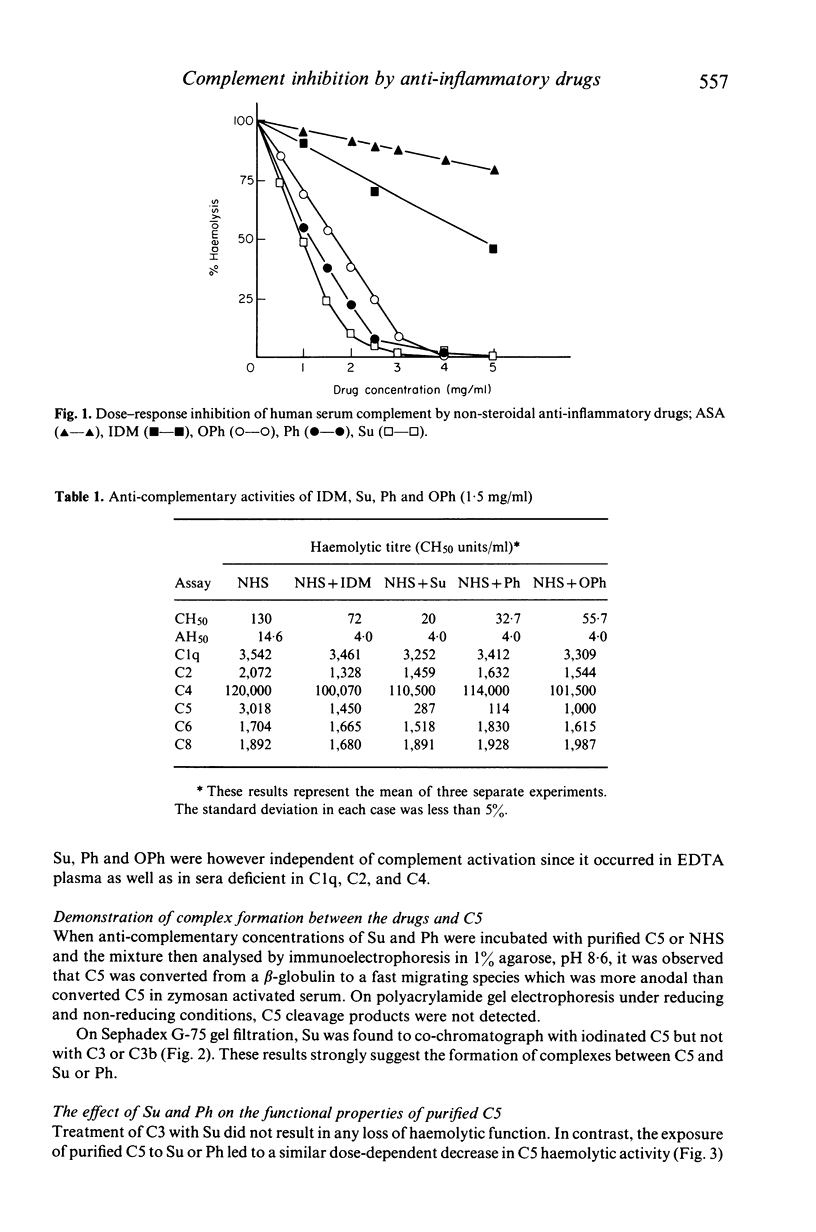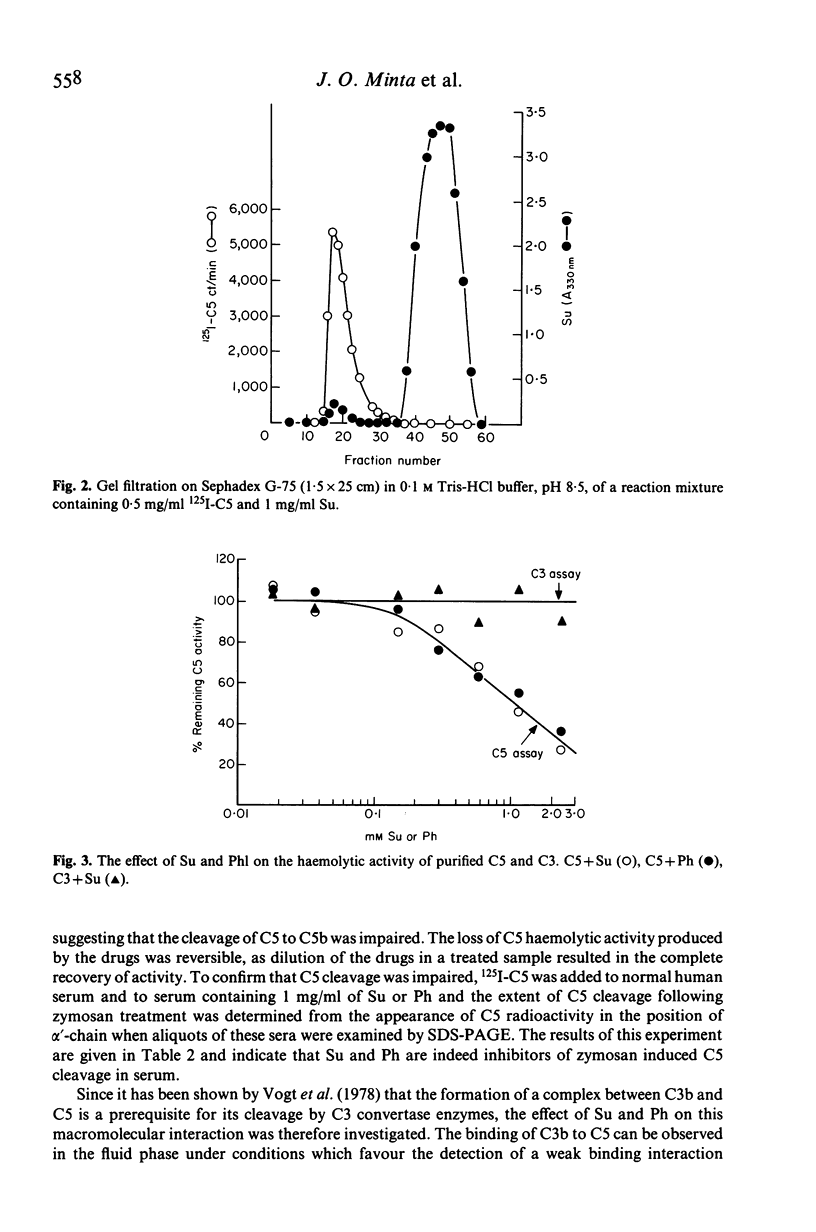Abstract
The possibility that the major non-steroidal anti-inflammatory drugs may inhibit the complement system and thus ameliorate the acute pathological changes induced by immune complexes was investigated. Treatment of fresh human serum with indomethacin (IDM), sulindac (Su), phenylbutazone (Ph) and oxyphenbutazone (OPh) inhibited both the classical and alternative complement (C) pathway activities in a dose-dependent fashion with a 50% inhibition dose of 4.65, 1.0, 1.65 and 1.3 mg/ml respectively. Aspirin, on the other hand, had a comparatively weak anti-complementary activity. Su, Ph and OPh were shown to form complexes with C5, thereby inhibiting the interaction between C3b and C5 and the cleavage of the latter into phlogistic fragments.
Full text
PDF






Selected References
These references are in PubMed. This may not be the complete list of references from this article.
- Chenoweth D. E., Hugli T. E. Demonstration of specific C5a receptor on intact human polymorphonuclear leukocytes. Proc Natl Acad Sci U S A. 1978 Aug;75(8):3943–3947. doi: 10.1073/pnas.75.8.3943. [DOI] [PMC free article] [PubMed] [Google Scholar]
- Cooper N. R., Müller-Eberhard H. J. The reaction mechanism of human C5 in immune hemolysis. J Exp Med. 1970 Oct 1;132(4):775–793. doi: 10.1084/jem.132.4.775. [DOI] [PMC free article] [PubMed] [Google Scholar]
- Fairbanks G., Steck T. L., Wallach D. F. Electrophoretic analysis of the major polypeptides of the human erythrocyte membrane. Biochemistry. 1971 Jun 22;10(13):2606–2617. doi: 10.1021/bi00789a030. [DOI] [PubMed] [Google Scholar]
- Gaither T. A., Alling D. W., Frank M. M. A new one-step method for the functional assay of the fourth component (C4) of human and guinea pig complement. J Immunol. 1974 Aug;113(2):574–583. [PubMed] [Google Scholar]
- Hong K., Kinoshita T., Miyazaki W., Izawa T., Inoue K. An anticomplementary agent, K-76 monocarboxylic acid: its site and mechanism of inhibition of the complement activation cascade. J Immunol. 1979 Jun;122(6):2418–2423. [PubMed] [Google Scholar]
- Hänsch G. M., Voigtländer V., Rother U. Effect of aspirin on the complement system in vitro. Int Arch Allergy Appl Immunol. 1980;61(2):150–158. doi: 10.1159/000232428. [DOI] [PubMed] [Google Scholar]
- Isenman D. E., Sundsmo J. S., Cooper N. R. The effects of mild reduction on the structure and function of C3. J Immunol. 1980 Oct;125(4):1798–1805. [PubMed] [Google Scholar]
- Minta J. O., Urowitz M. B., Gladman D. D., Irizawa T., Biggar W. D. Selective deficiency of the fourth component of complement in a patient with systemic lupus erythematosus (SLE): immunochemical and biological studies. Clin Exp Immunol. 1981 Jul;45(1):72–80. [PMC free article] [PubMed] [Google Scholar]
- Platts-Mills T. A., Ishizaka K. Activation of the alternate pathway of human complements by rabbit cells. J Immunol. 1974 Jul;113(1):348–358. [PubMed] [Google Scholar]
- Tack B. D., Prahl J. W. Third component of human complement: purification from plasma and physicochemical characterization. Biochemistry. 1976 Oct 5;15(20):4513–4521. doi: 10.1021/bi00665a028. [DOI] [PubMed] [Google Scholar]
- Tack B. F., Morris S. C., Prahl J. W. Fifth component of human complement: purification from plasma and polypeptide chain structure. Biochemistry. 1979 Apr 17;18(8):1490–1497. doi: 10.1021/bi00575a016. [DOI] [PubMed] [Google Scholar]
- Taniuchi S., Honjoh T., Tamoto K., Nakamura T., Koyama J. Different affinities of mono-, di- and tri-DNP- ribonuclease A for anti-DNP antibody. Mol Immunol. 1981 Apr;18(4):301–309. doi: 10.1016/0161-5890(81)90054-7. [DOI] [PubMed] [Google Scholar]
- Vane J. R. Inhibition of prostaglandin synthesis as a mechanism of action for aspirin-like drugs. Nat New Biol. 1971 Jun 23;231(25):232–235. doi: 10.1038/newbio231232a0. [DOI] [PubMed] [Google Scholar]
- Vogt W., Schmidt G., Hinsch B. Interference of propamidine with binding of the fifth component of complement to surface-fixed C3b, and with C5 activation. Immunology. 1979 Jan;36(1):139–143. [PMC free article] [PubMed] [Google Scholar]
- Vogt W., Schmidt G., Von Buttlar B., Dieminger L. A new function of the activated third component of complement: binding to C5, an essential step for C5 activation. Immunology. 1978 Jan;34(1):29–40. [PMC free article] [PubMed] [Google Scholar]
- Ward P. A., Newman L. J. A neutrophil chemotactic factor from human C'5. J Immunol. 1969 Jan;102(1):93–99. [PubMed] [Google Scholar]
- Weissmann G., Smolen J. E., Korchak H. M. Release of inflammatory mediators from stimulated neutrophils. N Engl J Med. 1980 Jul 3;303(1):27–34. doi: 10.1056/NEJM198007033030109. [DOI] [PubMed] [Google Scholar]
- Whaley K., Sloane D. J. Studies of the action of some anti-inflammatory drugs on complement mediated immune haemolysis. Br J Clin Pharmacol. 1975 Apr;2(2):123–129. doi: 10.1111/j.1365-2125.1975.tb01567.x. [DOI] [PMC free article] [PubMed] [Google Scholar]
- Zvaifler N. J. The immunopathology of joint inflammation in rheumatoid arthritis. Adv Immunol. 1973;16(0):265–336. doi: 10.1016/s0065-2776(08)60299-0. [DOI] [PubMed] [Google Scholar]


